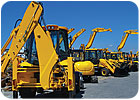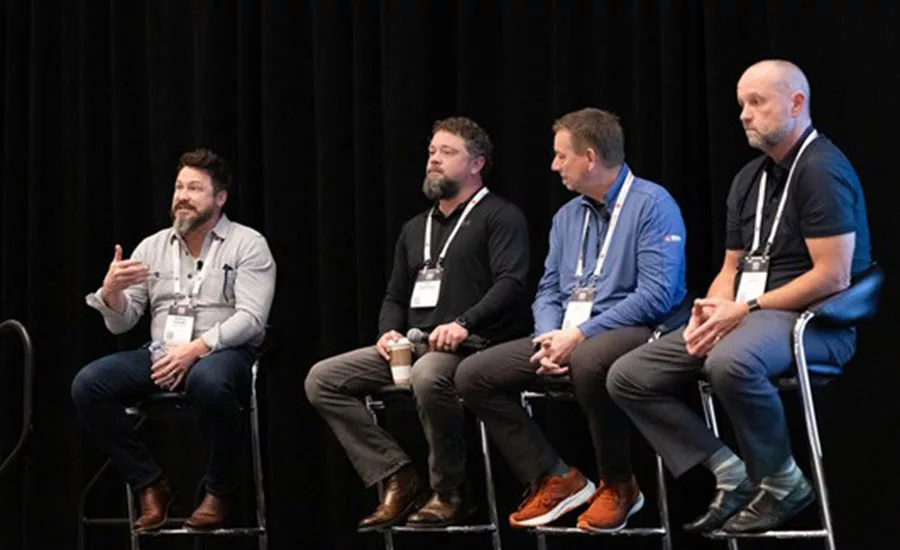Smart Business: Heavy Equipment Thefts Are On The Rise
If our economy had been growing at a rate of 20 percent a year for the last decade or so, most of us would be luxuriating in hog heaven right now. That’s apparently where a lot of heavy equipment thieves reside because that’s been the growth rate for heavy equipment thefts since 1996, according to the Insurance Services Office. ISO reports theft accounts for more than half of all insurance claims for heavy equipment - more than the combined totals from fire damage, collisions, vandalism, natural disasters and whatever else.

If our economy had been growing at a rate of 20 percent a year for the last decade or so, most of us would be luxuriating in hog heaven right now. That’s apparently where a lot of heavy equipment thieves reside because that’s been the growth rate for heavy equipment thefts since 1996, according to the Insurance Services Office. ISO reports theft accounts for more than half of all insurance claims for heavy equipment - more than the combined totals from fire damage, collisions, vandalism, natural disasters and whatever else.
According to Lojack Corporation’s “2007 Construction Equipment Theft Study,” the most commonly stolen pieces of equipment are:
1. Skid steers.
2. Loaders including backhoe loaders, skip loaders, wheel loaders and track loaders.
3. Generators/air compressors/welders.
4. Light utility/work trucks and trailers.
5. Forklifts/scissor lifts.
6. Dump trucks.
7. Light towers.
8. Mini excavators.
Lojack, a company that practically invented the stolen vehicle recovery market using radio frequency tracking integrated with law enforcement agencies throughout the United States, attributes much of the problem to professional theft rings that target construction equipment and are familiar with construction operations. The rewards far outweigh the risks in their “business.” The odds of getting caught are lower than for most other types of crime. When someone does get caught, prosecutors tend to assign it a low priority, and even if someone is convicted, penalties tend to be light. Add it all up and construction equipment theft has become an estimated $1 billion industry.
Value and mobility are the key factors determining risk for construction equipment. The higher the value and easier it is to transport, the more likely thieves are to target it. Often there is little machinery protection or jobsite security to deter them.
Whereas stolen autos have a recovery rate of around 62 percent, the best estimates are that only around 10 percent of pilfered heavy equipment gets recovered. There are various reasons for this. Most important seems to be the time lapse between theft and discovery. People tend to use their autos every day so usually no more than a few hours go by before they discover one missing. On the other hand, construction equipment stolen on a Friday night typically won’t get discovered until Monday morning. Statistics show that most thefts occur on weekends and holidays for precisely that reason.
Sometimes pieces of equipment sit idle for lengthy periods on a jobsite, and their loss might not get noticed for days or weeks, especially when it belongs to owners with large fleets and multi-site operations. The more time passes between theft and recovery, the easier it is for thieves to transport and sell the equipment outside of the vicinity.
Adding to the difficulty in recovering lost equipment is the absence of any central database of the kind that exists for motor vehicles, whose true owners can be readily identified by law enforcement officers. There is no mandated registration for off-road equipment, and no standard Product Identification Number (PIN) system like there is for autos.
Another factor is the ease at which used construction equipment can be sold. Stolen equipment often does not have the same kind of title documents as vehicles and can be sold without much risk to buyers who don’t ask many questions. Sad to say, but the construction industry is riddled with unscrupulous contractors who are anxious to cut a good deal on used equipment either knowing or not wanting to know if the property is “hot.”
Some contracts hold renters liable for stolen property. If you’re in the habit of renting heavy equipment, check the contract to make sure that you know who is liable for a theft loss and under what circumstances. If it is your insurance that will cover a theft loss, check with your insurance agent to make sure that you have the appropriate insurance to cover any liability that the rental contract imposes upon you.
Remember to ask the rental company for whatever security measures they can provide to make equipment harder to steal and easier to recover. These might include locks and tracking devices. Many rental fleets have registered their equipment on the National Equipment Register (NER, www.nerusa.com). NER warning decals deter thieves and the equipment is more likely to be recovered quickly, as police have 24-hour access to the machine’s identification information.
Other tips from NER and Lojack for safeguarding expensive construction equipment:
• Keep an accurate, updated list of equipment VIN and serial numbers.
• Store equipment in fenced-in areas or other places that are reasonably secure. Park equipment close together and in a circle if feasible, with smaller items in the center and chained to larger pieces.
• Some sources recommend “hiding” stored equipment in places not easily visible to onlookers. That could just as easily work to the advantage of the thieves, however. If the jobsite is in a well-populated residential area, it might be better to take the opposite approach and store equipment where plenty of eyeballs can see what’s going on.
• Remove batteries, fuses or ignition circuits from large machinery. Use immobilization devices such as wheel locks, fuel shut-offs or ignition locks. Consider installing battery-disconnect switches.
• Do not leave machinery on trailers, even if this does save a few minutes upon returning to the job. It also makes it easy for thieves to simply drive off with the trailers.
• Communicate with local police and let them know of expensive equipment stored at local jobsites. Request more frequent patrols in high-crime areas.
• Pay jobsite neighbors a few bucks to do spot checks over the weekend and notify the police immediately if they notice missing equipment.
• Post emergency contact numbers at jobsites.
With the run-up in gas and commodity prices, jobsites also are increasingly targeted for theft of copper tubing and even fuel, especially diesel. Leave gas tanks low instead of topping off at the end of a work week. This not only reduces potential loss but also makes it harder to siphon fuel tanks.
NER, in conjunction with a unit of the FBI, is hosting a series of free one-day regional summits in cities around the country to help equipment owners, insurers and law enforcement better combat equipment theft. Visit the following Web site for a schedule and registration instructions: www.nerusa.com/reg_summit.asp.

If our economy had been growing at a rate of 20 percent a year for the last decade or so, most of us would be luxuriating in hog heaven right now. That’s apparently where a lot of heavy equipment thieves reside because that’s been the growth rate for heavy equipment thefts since 1996, according to the Insurance Services Office. ISO reports theft accounts for more than half of all insurance claims for heavy equipment - more than the combined totals from fire damage, collisions, vandalism, natural disasters and whatever else.
According to Lojack Corporation’s “2007 Construction Equipment Theft Study,” the most commonly stolen pieces of equipment are:
1. Skid steers.
2. Loaders including backhoe loaders, skip loaders, wheel loaders and track loaders.
3. Generators/air compressors/welders.
4. Light utility/work trucks and trailers.
5. Forklifts/scissor lifts.
6. Dump trucks.
7. Light towers.
8. Mini excavators.
Lojack, a company that practically invented the stolen vehicle recovery market using radio frequency tracking integrated with law enforcement agencies throughout the United States, attributes much of the problem to professional theft rings that target construction equipment and are familiar with construction operations. The rewards far outweigh the risks in their “business.” The odds of getting caught are lower than for most other types of crime. When someone does get caught, prosecutors tend to assign it a low priority, and even if someone is convicted, penalties tend to be light. Add it all up and construction equipment theft has become an estimated $1 billion industry.
Value and mobility are the key factors determining risk for construction equipment. The higher the value and easier it is to transport, the more likely thieves are to target it. Often there is little machinery protection or jobsite security to deter them.
Whereas stolen autos have a recovery rate of around 62 percent, the best estimates are that only around 10 percent of pilfered heavy equipment gets recovered. There are various reasons for this. Most important seems to be the time lapse between theft and discovery. People tend to use their autos every day so usually no more than a few hours go by before they discover one missing. On the other hand, construction equipment stolen on a Friday night typically won’t get discovered until Monday morning. Statistics show that most thefts occur on weekends and holidays for precisely that reason.
Sometimes pieces of equipment sit idle for lengthy periods on a jobsite, and their loss might not get noticed for days or weeks, especially when it belongs to owners with large fleets and multi-site operations. The more time passes between theft and recovery, the easier it is for thieves to transport and sell the equipment outside of the vicinity.
Adding to the difficulty in recovering lost equipment is the absence of any central database of the kind that exists for motor vehicles, whose true owners can be readily identified by law enforcement officers. There is no mandated registration for off-road equipment, and no standard Product Identification Number (PIN) system like there is for autos.
Another factor is the ease at which used construction equipment can be sold. Stolen equipment often does not have the same kind of title documents as vehicles and can be sold without much risk to buyers who don’t ask many questions. Sad to say, but the construction industry is riddled with unscrupulous contractors who are anxious to cut a good deal on used equipment either knowing or not wanting to know if the property is “hot.”
Rental Equipment
Rented equipment is more likely to be stolen than equipment owned by a construction company. This is simply human nature at work. We are more likely to protect our own possessions than someone else’s. Rental equipment also tends to be newer and thus more desirable to thieves, and less likely to have security safeguards.Some contracts hold renters liable for stolen property. If you’re in the habit of renting heavy equipment, check the contract to make sure that you know who is liable for a theft loss and under what circumstances. If it is your insurance that will cover a theft loss, check with your insurance agent to make sure that you have the appropriate insurance to cover any liability that the rental contract imposes upon you.
Remember to ask the rental company for whatever security measures they can provide to make equipment harder to steal and easier to recover. These might include locks and tracking devices. Many rental fleets have registered their equipment on the National Equipment Register (NER, www.nerusa.com). NER warning decals deter thieves and the equipment is more likely to be recovered quickly, as police have 24-hour access to the machine’s identification information.
Other tips from NER and Lojack for safeguarding expensive construction equipment:
• Keep an accurate, updated list of equipment VIN and serial numbers.
• Store equipment in fenced-in areas or other places that are reasonably secure. Park equipment close together and in a circle if feasible, with smaller items in the center and chained to larger pieces.
• Some sources recommend “hiding” stored equipment in places not easily visible to onlookers. That could just as easily work to the advantage of the thieves, however. If the jobsite is in a well-populated residential area, it might be better to take the opposite approach and store equipment where plenty of eyeballs can see what’s going on.
• Remove batteries, fuses or ignition circuits from large machinery. Use immobilization devices such as wheel locks, fuel shut-offs or ignition locks. Consider installing battery-disconnect switches.
• Do not leave machinery on trailers, even if this does save a few minutes upon returning to the job. It also makes it easy for thieves to simply drive off with the trailers.
• Communicate with local police and let them know of expensive equipment stored at local jobsites. Request more frequent patrols in high-crime areas.
• Pay jobsite neighbors a few bucks to do spot checks over the weekend and notify the police immediately if they notice missing equipment.
• Post emergency contact numbers at jobsites.
With the run-up in gas and commodity prices, jobsites also are increasingly targeted for theft of copper tubing and even fuel, especially diesel. Leave gas tanks low instead of topping off at the end of a work week. This not only reduces potential loss but also makes it harder to siphon fuel tanks.
NER, in conjunction with a unit of the FBI, is hosting a series of free one-day regional summits in cities around the country to help equipment owners, insurers and law enforcement better combat equipment theft. Visit the following Web site for a schedule and registration instructions: www.nerusa.com/reg_summit.asp.
Looking for a reprint of this article?
From high-res PDFs to custom plaques, order your copy today!




